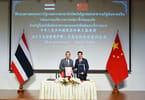Dr. Patrick Kalifungwa, Vice Chancellor at Livingstone International University of Tourism Excellence and Business Management (LIUTEBM) in Zambia, sent his address to the audience of the first general meeting of the International Council of Tourism Partners (ICTP) held in Seychelles on July 7, 2012. His timely and important address is reproduced here with his permission:
My address is based on various broad issues of tourism potential, threats, environmental economics, the green economy and the critique of the Green economy and finally the green growth as a policy strategy.
Zambia is located in the central part of Africa, which is the undiscovered paradise, the home of the Victoria Falls, the wonder of the world, and UNESCO’s World Heritage site. Zambia’s protection of the wildlife, flora, and fauna is vital in nurturing the growing eco-tourism and ensuring a better and safer Zambia for the inhabitants and the vigorous wildlife community. This rich tourism offering of Zambia will enhance quality green growth. It embraces the green growth vision for tourism and quality green growth at the destination level.
The partnerships, linkages, and collaboration of universities, institutions of higher learning, and various stakeholders will enhance training and research in tourism and will impact positively on the strength of tourism and objectives of ICTP. The alliances of destinations, organizations, the global eco-partnership, and the coalition of various global stakeholders with a common vision to provide quality service and green growth, is the world’s new innovation, which is truly meaningful alliances, which will provide greater and stronger resources to enrich and protect our environment and take the tourism industry to a very different level.
Overview
Tourism has reached its pinnacle in its life span with most nations benefiting from tourism and sustaining their economies. Tourism is a valuable source of revenue; it should be supported as a means to foster sustainable development in various countries and to the benefit of the people.
Various benefits have been recorded as the ultimate deliverables of tourism development such as economic, cultural, and social benefits, which have been derived from success stories of tourism.
However, detrimental consequences arise from tourism, which require mitigating and sustainable management action. The depletion of Earthly provisions for health living, mitigating and adaptation to the changes in climate are inevitable. Global action is eminent to mitigate the shortcomings of human activities.
The benefits and opportunities of the tourist attractions have to be harnessed to further expand the returns. Development of infrastructure, superstructures, and human capital and capacity building in various destinations in the third world remain the challenges to tourism development. Marketing of our facilities and tourism products has also met with myriad obstacles and challenges including budgetary restrictions. The knowledge and skills gap of our operators and various stakeholders is also constrained due to lack of collaborative efforts and linkages. The knowledge and skills development will further enhance the capacity of players in the industry.
It is from this collaborative angle that academics should develop their partnerships, linkages, collaboration, and exchange their skills through scholars, students and share the research projects and programs, which will result and bring home the strength of tourism through ICTP. Partnerships are critical in attracting resources to plan, manage, and evaluate the ICTP strategies. For the success of ICTP, we need to develop solid partnerships and strong linkages among all the players and develop a sense of sharing a common vision and let’s enjoy that.
Green Growth has become a policy focus that emphasizes environmentally-sustainable economic progress to foster low-carbon and socially inclusive development. This is a globally-relevant approach to sustainable economic growth; it is imperative that we support the policy initiatives to continue with economic growth to alleviate poverty and to achieve social progress in our various countries. However, increased environmental degradation, climate change, and diminishing natural resources require an unconventional approach to support our economic activities.
In order to achieve green growth, it is crucial to change development approaches to a more responsible long-term attitude. Governments can promote this by encouraging economic growth with an emphasis on environmental and social concerns.
Environmental economics
Environmental economics is distinguished from ecological economics that emphasizes the economy as a subsystem of the ecosystem with its focus upon preserving natural capital (Jeroen C.J.M. Van den Bergh 2001). One survey of German economists found that ecological and environmental economics are different schools of economic thought, with ecological economists emphasizing “strong” sustainability and rejecting the proposition that natural capital can be substituted by human-made capital (Illge L, Schwarze R. 2006) – a matter of opinion.
Central to environmental economics is the concept of market failure. Market failure means that markets fail to allocate resources efficiently. As stated by Hanley, Shogren, and White (2007) in their textbook, Environmental Economics, “a market failure occurs when the market does not allocate scarce resources to generate the greatest social welfare. A wedge exists between what a private person does, given market prices, and what society might want him or her to do to protect the environment. Such a wedge implies wastefulness or economic inefficiency; resources can be reallocated to make at least one person better off without making anyone else worse off. Common forms of market failure include externalities, non-excludability, and non-rivalry.”
The basic problem is that if people ignore the scarcity value of the commons, they can end up expending too much effort, over harvesting resources (e.g., a fishery). Hardin theorized that in the absence of restrictions, users of an open-access resource will use it more than if they had to pay for it and had exclusive rights, leading to environmental degradation. However, Ostrom’s (1990) work on how people using real common property resources, have worked to establish self-governing rules to reduce the risk of the tragedy of the commons (Ostrom, E. 1990. Governing the commons. Cambridge University Press).
Solutions advocated to correct such externalities include environmental regulations: under this plan, the economic impact has to be estimated by the regulator. Usually this is done using cost-benefit analysis. There is a growing realization that regulations (also known as “command and control” instruments) are not as distinct from economic instruments as is commonly asserted by proponents of environmental economics.
Green economy
The green economy is one that results in improved human well-being and social equity, while significantly reducing environmental risks, and [an] ecological green economy is an economy or economic development model based on sustainable development and knowledge of ecological economics.
Karl Burkart, defines a green economy as based on six main factors:
1 – Renewable energy (solar, wind, geothermal, marine including wave, biogas, and fuel cell).
2 – Green buildings (green retrofits for energy and water efficiency, residential and commercial assessment; green products and materials, and LEED construction).
3 – Clean transportation (alternative fuels, public transit, hybrid and electric vehicles, car sharing and carpooling programs.
4 – Water management (water reclamation, grey water and rainwater systems, low-water landscaping, water purification, storm water management).
5 – Waste management (recycling, municipal solid, waste salvage, Brownfield, land remediation, superfund cleanup, sustainable packaging).
6 – Land management (organic agriculture, habitat conservation and restoration; urban forestry and parks, reforestation and afforestation and soil stabilization.
The global citizens center, led by Kevin Danaher, defines green economy differently from the use of pricing mechanisms for protecting nature, by using the terms of a “triple bottom line,” an economy concerned with being:
1 – Environmentally sustainable, based on the belief that our biosphere is a closed system with finite resources and limited capacity for self-regulation and self-renewal.
We depend on the Earth’s natural resources, and, therefore, we must create an economic system that respects the integrity of ecosystems and ensures the resilience of life supporting systems.
2 – Socially just, based on the belief that culture and human dignity are precious resources that, like our natural resources, require responsible stewardship to avoid their depletion. We must create a vibrant economic system that ensures all people have access to a decent standard of living and full opportunities for personal and social development.
3 – Locally rooted, based on the belief that an authentic connection to place is the essential pre-condition to sustainability and justice. The green economy is a global aggregate of individual communities meeting the needs of its citizens through the responsible, local production and exchange of goods and services.
The Global Green Economy Index
The Global Green Economic Index is published annually by consultancy Dual Citizen Inc.; this measures and ranks the perception and performance of 27 national green economies. This index looks at 4 primary dimensions defining a national green economy as follows, that:
1 – Leadership and the extent to which national leaders are champions for green issues on the local and international stage.
2 – Domestic policies and the success of policy frameworks to successfully promote renewable energy and green growth in home market.
3 – Cleantech investment and the perceived opportunities and cleantech investment climate in each country.
4 – Green tourism and the level of commitment to promoting sustainable tourism through government.
The green economy includes green energy generation based on renewable energy to substitute for fossil fuels and energy conservation for efficient energy use.
Because the market failure related to environmental and climate protection as a result of external costs, high future commercial rates and associated high initial costs for research, development, and marketing of green energy sources, and green products prevents firms from being voluntarily interested in reducing environment – unfriendly activities (Reinhardt, 1999; King and Lenox, 2002; Wagner, 2003; Wagner, et.al, 2005), the green economy may need government subsidies as market incentives to motivate firms to invest and produce green products and services. The German Renewable Energy Act, legislations of many other EU countries, and the American Recovery and Reinvestment Act of 2009, all provide such market incentives.
Critique of the “green economy”
A number of organizations have critiqued aspects of the “green economy,” particularly the mainstream conceptions of it based on using price mechanisms to protect nature, arguing that this will extend corporate control into new areas from forestry to water. The research organization, Etcgroup, argues that the corporate emphasis on bio-economy “will spur even greater convergence of corporate power and unleash the most massive resource grab in more than 500 years.” Venezuelan Professor, Edgardo Lander, says that the UNEP’s report, Towards a Green Economy, while well-intentioned, “ignores the fact that the capacity of existing political systems to establish regulations and restrictions to the free operation of the markets – even when a large majority of the population calls for them – is seriously limited by the political and financial power of the corporations.” Ulrich Hoffmann, in a paper for UNCTAD, also says that the focus on green economy and “green growth” in particular, “based on an evolutionary (and often reductionist) approach, will not be sufficient to cope with the complexities of climate change” and “may rather give much false hope and excuses to do nothing really fundamental that can bring about a u-turn of global greenhouse gas emissions.”
In conclusion: green growth as a policy strategy
Green growth is a term to describe a path of economic growth, which uses natural resources in a sustainable manner. It is used globally to provide an alternative concept to standard economic growth. The term green growth has been used to describe national or international strategies. As agreed at the fifth ministerial conference on environment development in Asia and Pacific, green growth is a strategy for achieving sustainable development. It is focused on overhauling the economy in a way that synergizes economic growth and environmental protection, building a green economy in which investments in resource savings, as well as sustainable management of natural capital, are drivers of growth. An economy which is in closer alignment with sustainable development objectives provides opportunities for using financial resources better to meet development needs and reducing the vulnerability of socioeconomic systems to environmental change and resource constraints.
Green growth strategies can help economies and societies become more resilient as they work to meet demands for food production, transport, housing, energy, and water. Strategies can help mitigate the impacts of adverse shocks by reducing the intensity of resource consumption and environmental impacts, while alleviating pressure on commodity prices. Green growth also offers competitive advantages to those countries that commit to policy innovations. The global market for green goods and services is vast and growing fast, offering countries the dual benefit of prosperity and job creation (Green Growth, Resources & Resilience).
WHAT TO TAKE AWAY FROM THIS ARTICLE:
- The alliances of destinations, organizations, the global eco-partnership, and the coalition of various global stakeholders with a common vision to provide quality service and green growth, is the world's new innovation, which is truly meaningful alliances, which will provide greater and stronger resources to enrich and protect our environment and take the tourism industry to a very different level.
- The partnerships, linkages, and collaboration of universities, institutions of higher learning, and various stakeholders will enhance training and research in tourism and will impact positively on the strength of tourism and objectives of ICTP.
- Patrick Kalifungwa, Vice Chancellor at Livingstone International University of Tourism Excellence and Business Management (LIUTEBM) in Zambia, sent his address to the audience of the first general meeting of the International Council of Tourism Partners (ICTP) held in Seychelles on July 7, 2012.






















